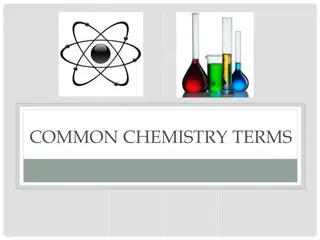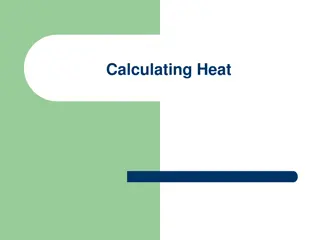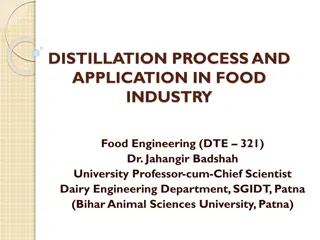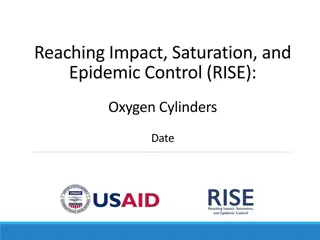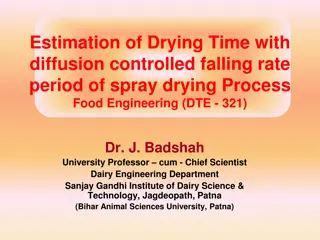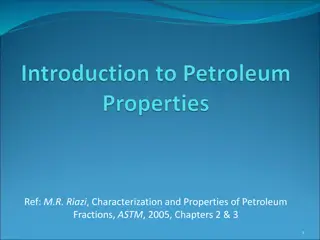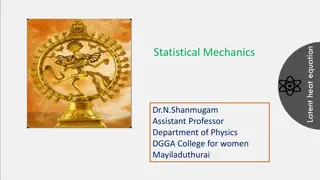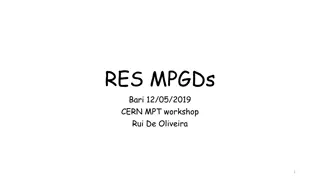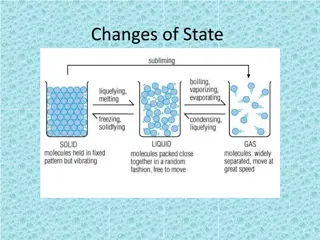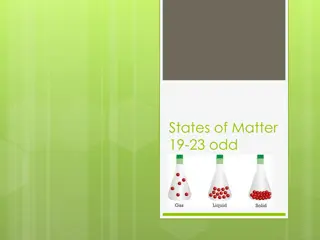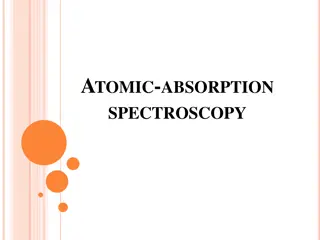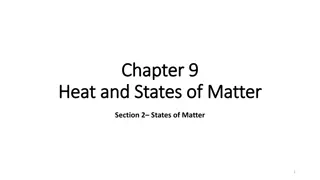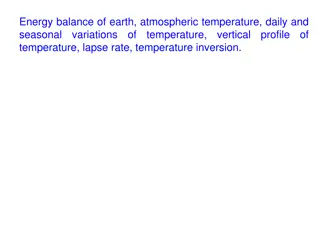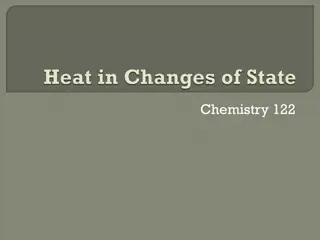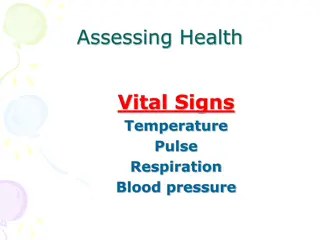Understanding Common Chemistry Terms and Processes
Explore essential chemistry concepts such as matter, pH, acids, bases, mixtures, solutions, vaporization, sublimation, deposition, condensation, and freezing. Learn about the different states of matter, types of mixtures, and physical changes occurring in substances. Enhance your knowledge of chemis
0 views • 39 slides
Understanding Heat and Energy Changes in Chemistry
Explore the concepts of heat, specific heat, phase change, and energy calculations in chemistry. Learn how to calculate heat, specific heat values for different substances, and the energy needed for phase changes like vaporization and fusion. Practice problems and examples are provided to enhance un
0 views • 12 slides
Distillation Process and Applications in Food Industry
Distillation is a separation process used in the food industry to separate components in a mixture based on their volatility. It involves vaporization, condensation, and re-evaporation to achieve separation. Steam distillation is a method where steam is used to reduce boiling temperatures for safe s
1 views • 13 slides
Comprehensive Guide to Oxygen Storage and Handling Methods
Explore the various methods of storing and handling oxygen, including types of storage devices, sources of medical oxygen, liquid oxygen containers, and cryogenic liquid cylinders. Learn about the different containers used, storage quantities, vaporization rates, and safety measures involved in stor
0 views • 61 slides
Estimation of Drying Time in Spray Drying Process: Diffusion and Falling Rate Periods
The estimation of drying time in a spray drying process involves understanding diffusion-controlled falling rate periods, constant rate periods, and the mechanisms by which moisture moves within the solid. The drying rate curves depend on factors like momentum, heat and mass transfer, physical prope
0 views • 8 slides
Understanding Petroleum Fraction Distillation Curves
Characterization and properties of petroleum fractions are essential for understanding their behavior, particularly through distillation curves. These curves depict the boiling points of crude oil or petroleum fractions, highlighting components' volatility ranges. Various methods like ASTM D86, True
0 views • 28 slides
Fundamentals of Material Science in Pharmaceutical Formulation
This chapter delves into key principles such as heat of vaporization, Fick's law, Noyes-Whitney equation, phase diagrams, solubility factors like particle size and pH adjustment in pharmaceutical formulation. Understanding these concepts is crucial for optimizing drug delivery systems.
0 views • 29 slides
Understanding Phase Transformations and Latent Heat Equation in Statistical Mechanics
In this informative piece by Dr. N. Shanmugam, Assistant Professor at DGGA College for Women, Mayiladuthurai, the concept of phase transformations in substances as they change states with temperature variations is explored. The latent heat equation is discussed along with definitions of fusion, vapo
1 views • 22 slides
Kanthal Wire Mesh Reliable and Long-Lasting
From Nickel-wiremesh.com, you can acquire information regarding the precision and durability of Kanthal wire mesh. Enjoy the pinnacle of vaporization with our premium products.\n\n\/\/nickel-wiremesh.com\/
1 views • 1 slides
Innovative Resistive Layers and Structures for Particle Detection at CERN
Explore the latest advancements in resistive layers and structures designed for particle detection at CERN. The research covers various types of resistive structures, including GEM and BULK Micromegas, and delves into topics such as spark protection, energy levels, and material vaporization. Detaile
0 views • 39 slides
Understanding Changes of State in Matter
Changes of state in matter refer to the physical transitions that substances undergo, such as melting, freezing, vaporization, and condensation. These transitions involve the addition or removal of energy, impacting the movement of particles and their arrangement. Despite the transformations, the id
0 views • 10 slides
Understanding States of Matter: Kinetic Molecular Theory and Phase Transitions
Exploring the fundamental concepts of the states of matter, this content delves into the Kinetic Molecular Theory, explaining how matter changes from solid to liquid to gas based on particle movement and energy levels. It further discusses the nature of gases and liquids, vaporization, evaporation,
0 views • 17 slides
Understanding Atomic Absorption Spectroscopy in Analytical Chemistry
Atomic absorption spectroscopy (AAS) is a valuable technique for determining metal concentrations in samples. This method involves the absorption of light to measure gas-phase atoms, requiring steps like desolvation, vaporization, and volatilization to convert samples into atomic gas. The process ut
0 views • 18 slides
Understanding the Four States of Matter and Changes in States
Explore the four states of matter - solid, liquid, gas, and plasma - and understand their unique characteristics based on the attractions of their particles. Learn how heat energy can cause transitions between these states, such as melting, freezing, vaporization, condensation, and sublimation.
0 views • 7 slides
Understanding Earth's Energy Balance and Temperature Variations
Earth's energy balance is crucial for maintaining atmospheric temperature and regulating daily and seasonal temperature changes. The net radiation, consisting of incoming shortwave and outgoing longwave radiation, plays a key role in this balance. Components such as sensible heat flux, latent heat o
0 views • 18 slides
Understanding Heat Transfer in Phase Changes of Water
Water molecules exhibit different behaviors in the liquid and gaseous states due to varying attractions between molecules. To change liquid water to a gas, energy must be added to overcome intermolecular forces, making this process endothermic. The heat absorbed during melting is equal to the heat r
0 views • 22 slides
Understanding Body Temperature Regulation and Factors Affecting It
Body temperature regulation is a complex process involving the balance of heat production and loss. Factors like age, hormones, stress, and environmental changes can influence body temperature. Heat production is affected by factors such as basal metabolic rate, muscle activity, fever, and sympathet
0 views • 24 slides
